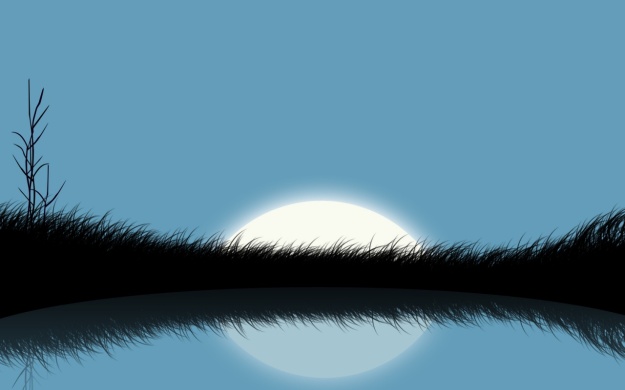We are used to thinking of the moon and sun as opposites, a fallacy that even pervades astronomy, as Space.com points out. For a single instant in a lunar month (29.5 days) the sun is opposite the moon in the sky. This is the exact moment of the full moon. Apart from this, the two may be anything from 180 to 0 degrees apart, and are often seen in the sky together.
This may explain why Völuspá refers to the moon-god Mani as the sun’s companion or escort. (Depending on translation.) Also, when the two appear in the sky for the first time, their routes are not yet established, so it makes sense that they would be together.
(Whether they decide their routes or not is an interesting point, but there’s nothing in Vsp. to tell us. Snorri would probably say that Odin and the gods decided their routes, but in Vsp. the gods decide the names of times, after the sun and moon travel the heavens.)
At any rate, the sun and moon are not seen as opposing forces, but as working together, probably because they are siblings. As I noted in my post on their father, Mundilfare, they are turning the mill-handle named for their father, the mill that turns the heavens, so they have to work together.
I will be writing more about Sol in another post, but now I want to focus on her brother the moon, and what we can deduce about his powers.
Moon, Measure and Mind
One place to start is his name, which is cognate with the words for “moon”, in most Indo-European languages. He also has a very close analogue in the Baltic moon-god Meness, although the brother/husband of the sun-goddess there has a much more antagonistic relationship with his sister/spouse.
The Indo-European word for ‘month” was often based on the word for moon, as well as the word for “measure“. While this may seem obvious, the mental leap needed to compute and track months gave us gods like the Egyptian Thoth, master of maths and calendars. Alvíssmál is clear on the moon’s function as timekeeper:
14. ‘”Moon” it’s called by men but “glow-ball” by the gods,
they call it “spinning wheel” in Hel;
“speeder” giants, “shining” dwarfs,
the elves call it “tally of years”.
Orchard’s trans)
In Vsp, as soon as the moon and sun are in the sky, the gods go to their assembly and put names to the times of day. Also, in the tally of dwarfs that comes a few verses later, two are called “New-moon” and “Moon-wane”. In Vafþruðnismál, the moon and sun travel the sky “for men to tell the time”. (Stone: 50)
Further, the moon has been linked to the mind in Indo-European thought, especially by Bruce Lincoln. It makes sense that the sun would be the seat of emotion, which is an immediate response, while the moon, which shines with reflected light, would be the seat of reflection. Reason is how we interpret and analyze our immediate reactions to things. (Lincoln also mentions that clouds are thoughts, an amusing analogy.)
(Lucy Goodison had some interesting work on pre-Mycenean Greece showing that they shared this belief – the sun as a vital, emotional force and the moon as a reflecting, rational one. This would not be Indo-European, of course, but it does show that the idea was out there.)
This last is total speculation, of course, but I can’t help but think that the same ability to abstract that gave us time-keeping in the first place would naturally be linked to the moon. (And before anyone starts complaining that I’ve made rationality = male, I invite you to consider who might be tracking the phases of the moon, and for what purposes.)
 The fate of the sun (and moon) in Vsp tells us about the beginning and ending of time. They emerge at the beginning of things to measure out time and start the heavens moving, and at the end the wolves devour them (in the poem, only the sun is mentioned) to show that time is at an end. The death of the sun is the visible sign of the Ragnarök, as the darkness covers all.
The fate of the sun (and moon) in Vsp tells us about the beginning and ending of time. They emerge at the beginning of things to measure out time and start the heavens moving, and at the end the wolves devour them (in the poem, only the sun is mentioned) to show that time is at an end. The death of the sun is the visible sign of the Ragnarök, as the darkness covers all.
PS – In the poem Hávamál Odin advises to invoke the moon “against malice” (verse 137). It is not entirely clear what he means by this, but the moon, as the seat of thought, could ward against evil thoughts and speech. (The Baltic Meness, who was a bit more warlike, gave his strength and ability to renew to all things. Mani may also have been able to lend strength and resilience to someone suffering from the malice of others.)
The Elder Edda, a Book of Viking Lore, Andy Orchard (trans.), Penguin Classics, 2011.
Goodison, Lucy 1992: Moving Heaven and Earth: Sexuality, Spirituality, and Social Change, Pandora Press.
Lincoln, Bruce 1986: Myth, Cosmos and Society: Indo-European Themes of Creation and Destruction, Harvard University Press.
Stone, Alby 1997: Ymir’s Flesh: North European Creation Mythologies, Capall Bann.
If you like the image at the top, click here.


Who seeing a full moon cold have malice toward it?
LikeLiked by 1 person
Pingback: Turning the Heavens: Mundilfare | We Are Star Stuff
Whatever and however – the full moon does have an incredible effect on nature. Birds, animals and humans often bizarre behaviour. The moon remains the same.
LikeLike
Pingback: Sunna’s Stead | We Are Star Stuff
Pingback: Spirits of the Northern Lights | The Lefthander's Path